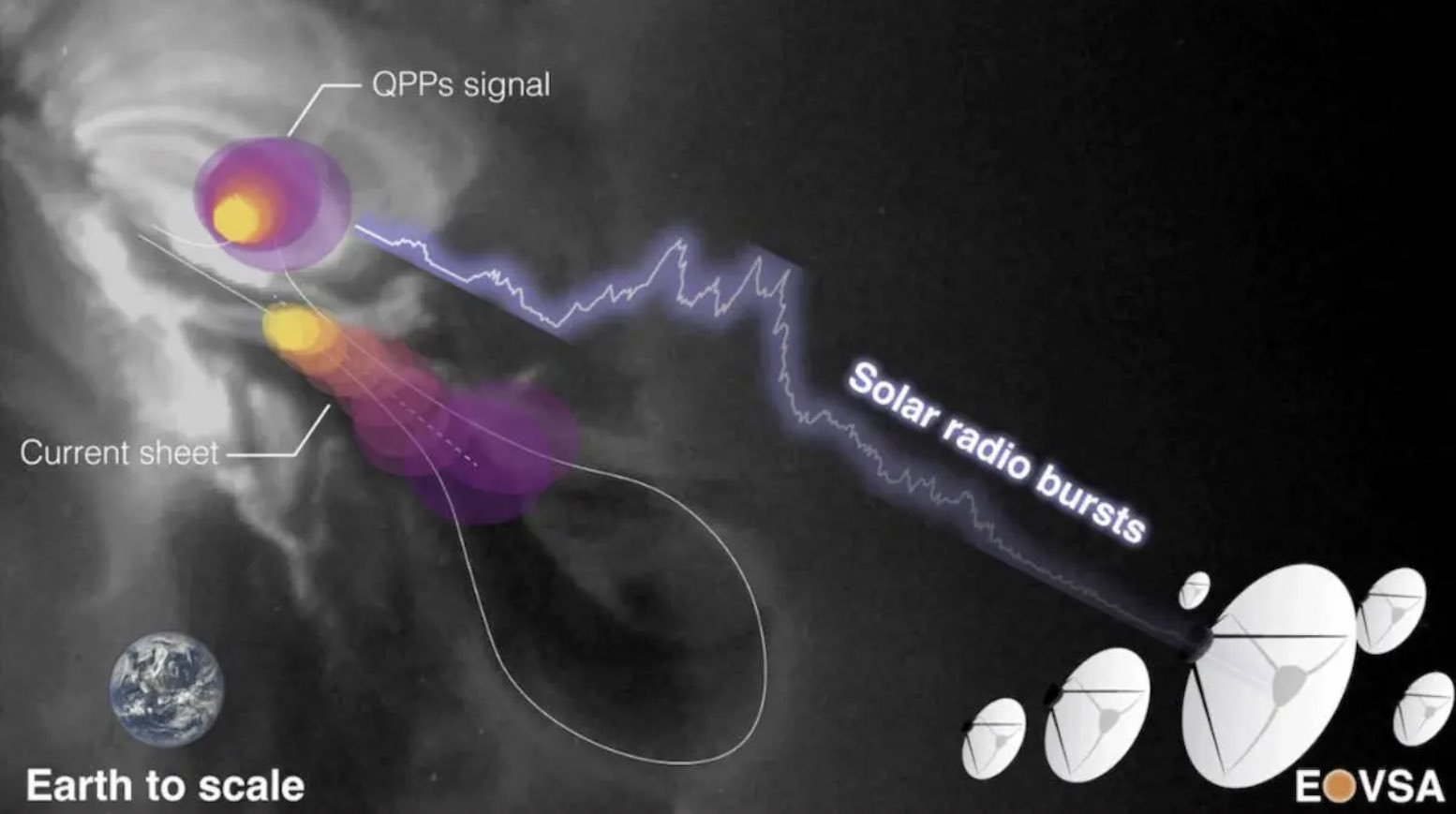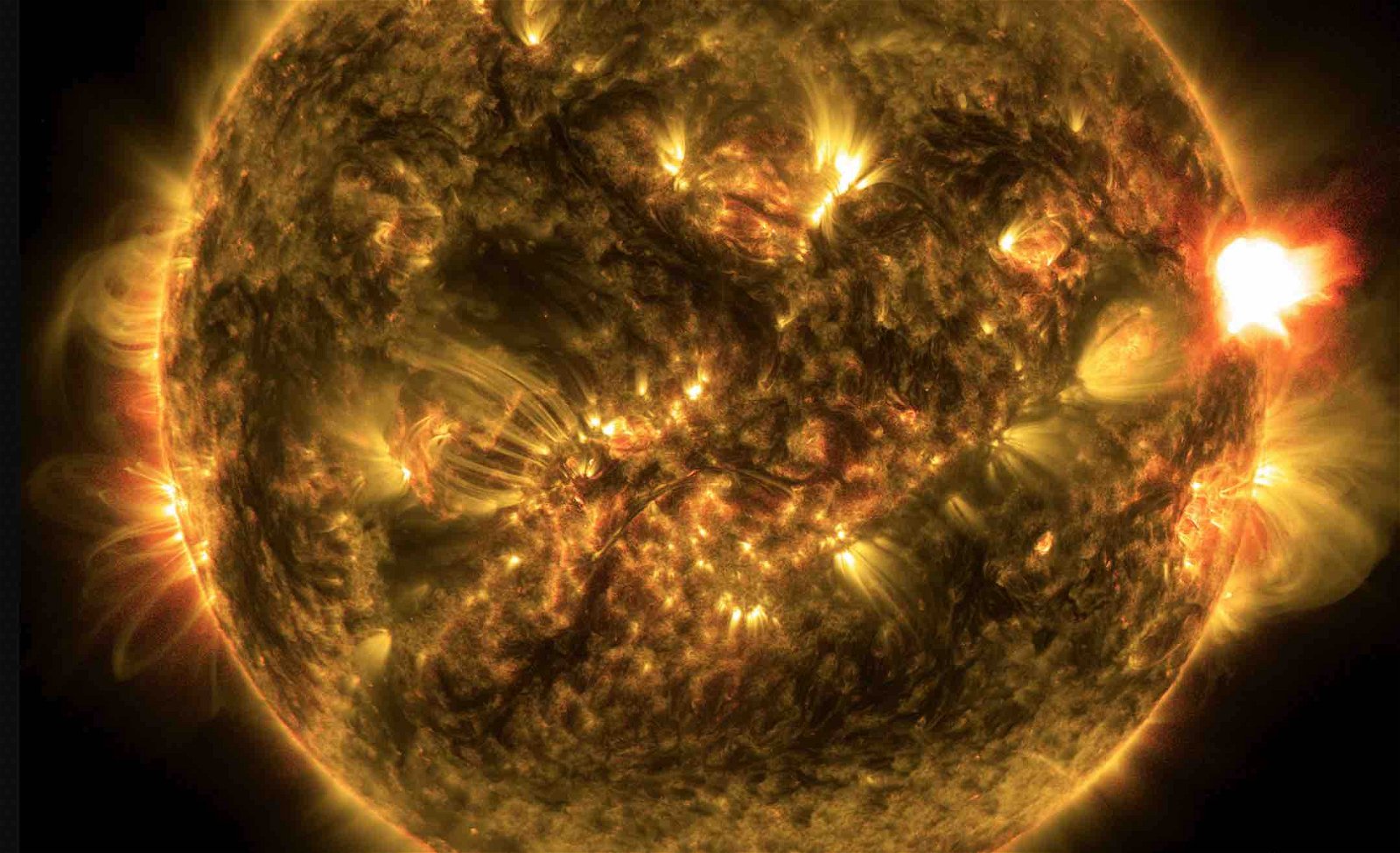A new study reveals the source of a curious feature of the Sun’s atmosphere that produces a signal pattern that researchers have likened to a human heartbeat.
The discovery, reported by an international team in Nature Communications, reveals the source of radio emissions that produce the unique signal within a C-class solar flare positioned some 3100 miles above the Sun’s surface.
The discovery is more than just a novelty though: researchers involved with the study say their findings may help solar scientists better understand the mechanism behind solar flares, the most powerful energy blasts that occur anywhere in our solar system which are also often associated with the production of such repeating patterns.
The team’s discoveries arose primarily from observations of a solar flare that occurred on July 13, 2017, which was captured by the Expanded Owens Valley Solar Array (EOVSA), a telescope located at Owens Valley Radio Observatory (OVRO) near Big Pine, California.
“EOVSA routinely observes the Sun in a wide range of microwave frequencies over 1 to 18 gigahertz,” read a statement describing the research, “and is sensitive to radio radiation emitted by high-energy electrons in the Sun’s atmosphere, which are energized in solar flares.”
Sijie Yu, an astronomer with the New Jersey Institute of Technology’s Center for Solar-Terrestrial Research and one of the paper’s corresponding authors, called the discovery “unexpected.”
“This beating pattern is important for understanding how energy is released and is dissipated in the Sun’s atmosphere during these incredibly powerful explosions on the Sun,” Yu said in a statement, adding that the origins of these unusual heartbeat-like emissions, which are formally called quasi-periodic pulsations (QPPs), have long remained a mystery.
According to their study, the researchers say microwave QPPs originate during a process called quasi-periodic magnetic reconnection in the region known as the flare current sheet, an area where energies from reconnection are released and converted into other forms.
The researchers write that these microwave QPPs “appear as two vertically detached but closely related sources with the brighter ones located at flare loops and the weaker ones along the stretched current sheet.”


“Although the brightness temperatures of the two microwave sources differ greatly,” the researchers write, they appear to vary in phase over periods lasting from 10-20 seconds and 30-60 seconds respectively, producing rhythmic emissions the team likened to solar “heartbeats.”
“The repeating patterns are not uncommon for solar radio bursts,” said Yuankun Kou, a Ph.D. student at Nanjing University (NJU) and lead author of the new study.
However, Kou said he and the team were surprised that the 10-20 second microwave source was accompanied by the secondary pulse occurring at 30-60 seconds.
“Interestingly, there is a secondary source we did not expect located along the stretched current sheet that pulses in a similar fashion as the main QPP source,” Kuo said.
“This is the first time a quasi-periodic radio signal located at the reconnection region has been detected,” Kuo adds. “This detection can help us to determine which of the two sources caused the other one.”
Kuo and the team believe the highly energetic electrons accelerated by these quasi-periodic reconnections arise “from the modulation of magnetic islands within the current sheet,” according to the new paper, which the authors say can be validated using magnetohydrodynamic simulations.
Bin Chen, an associate professor of physics at NJIT and the new paper’s co-author, said their observations provide “a strong indication that the two QPPs sources are closely related.”
“The appearance of magnetic islands within the long-stretched current sheet plays a key role in tweaking the energy release rate during this eruption,” Cheng says, adding that periodic energy releases the team observed probably result in a repetitive production of the high-energy electrons the team observed, which are thereafter detected once they manifest “as QPPs in the microwave and soft X-ray wavelengths.”
“We’ve finally pinpointed the origin of QPPs in solar flares as a result of periodic reconnection in the flare current sheet,” Yu said, who added that the team’s study could lead to future reinterpretations of reported QPP events, as well as the role they play with relation to solar flares.
The paper by Yu, Kou, Chen, et al., titled “Microwave imaging of quasi-periodic pulsations at flare current sheet,” appeared in Nature Communications.
Micah Hanks is the Editor-in-Chief and Co-Founder of The Debrief. He can be reached by email at micah@thedebrief.org. Follow his work at micahhanks.com and on Twitter: @MicahHanks.

